Considerations of Use for Dosimeters
Factors to Consider With the Use of a Dosimeter Include:
- The microphone must be placed in the employee's hearing zone. OSHA defines the hearing zone as a sphere with a two-foot diameter surrounding the head. Additional information (App III: B) on general sampling protocol is also available.
- Select specific instrument settings for the dosimeter.
Settings
According to OSHA's noise standard 29 CFR 1910.95, the noise dosimeter is the primary instrument for making compliance measurements. The following dosimeter settings must be utilized:
- Exchange rate: 5 decibels (dB)
- Frequency weighting: A
- Response: slow
- Criterion level: 90 dBA
- Threshold: 80 dBA or 90 dBA
A dosimeter with a threshold of 80 dBA as well as one with a threshold of 90 dBA should be used to measure noise exposures (most modern dosimeters utilize simultaneous 80 and 90 dBA threshold settings), as follows:
- The 80 dBA threshold dosimeter is used to measure the noise dose of those employees identified during the walk-around whose exposure may exceed the 85 dBA time-weighted average (TWA) limit.
- The 90 dBA threshold dosimeter is used to measure the noise dose of those employees identified during the walk-around whose exposure may exceed the 90 dBA permissible exposure level (PEL).
Note: Paragraphs 29 CFR 1910.95(a) and 29 CFR 1910.95(b) of OSHA's noise standard date back to the 1969 Walsh-Healey Act. This early standard predated noise dosimetry and OSHA had no instructions for taking noise measurements, and so the first dosimeters that were developed used 90 dBA both as the threshold and criterion levels. Paragraph 29 CFR 1910.95(c) of the 1983 Hearing Conservation Amendment to the Occupational Noise Exposure Standard requires employers to administer a continuing, effective hearing conservation program for all employees whose noise exposures equal or exceed an 8-hour time-weighted average (TWA8) of 85 dBA or, equivalently, a noise dose that is equal to 50 percent of the PEL. The standard requires that all continuous, intermittent, and impulsive sound levels from 80 dB to 130 dB be included in the measurement of dose.
Dosimeter Readout
The hypothetical exposure situations shown in the table below illustrate the relationship between criterion level, threshold, and exchange rate and show the importance of using a dosimeter with an 80 dBA threshold to characterize an employee's noise exposure. An instrument with a 90 dBA threshold will not capture any noise below that level, and will thus give a readout of 0 percent even if the employee being measured is actually being exposed to 89 dBA for eight hours (equivalent to 87 percent of the allowable noise dose over any eight hour period).

Some dosimeters indicate when a 115 dBA (A-weighted decibel) sound level has been exceeded. Do not use this indication for compliance determination.
Use the Noise Dose Reading
The noise dose provided by dosimeters can be used to calculate both the continuous equivalent A-weighted sound level (LA) and the eight hour TWA for the time period sampled.

Equation Two is used for enforcement purposes and Equation One can be used to assist in evaluating hearing protectors and engineering controls. Note: Most dosimeters perform the above calculation and automatically provide data for LA and TWA.
NOTE: In general, for enforcement purposes a 90-dBA threshold dosimeter is necessary to establish noncompliance with Table G-16 or Table D-2. However, in unusual situations, results obtained with an 80-dBA threshold dosimeter may be discussed with the ARA for Technical Support to determine whether they sufficiently demonstrate noncompliance with Table G-16 or Table D-2.
- S1.25-1991, "Specifications for Personal Noise Dosimeters." Some older dosimeters only meet the 1978 version of this standard. The 1978 version was not intended for measuring noise that is predominantly impulsive. For noise that is impulsive in nature, a dosimeter meeting the 1991 version of the standard is recommended.
- As a minimum, sampling should be conducted for a length of time necessary to establish whether exposures are above the limits permitted by Table G-16, Table G-16a, or Table D-2 (for general industry or construction workplaces, respectively). Instrument accuracy must be taken into account.
- Consider the following with respect to the monitoring results:
- TWA exposures at or above the action level of 85 dBA require a hearing conservation program [29 CFR 1910.95(c-n)] (results obtained from the 80 dBA threshold).
- TWA exposures exceeding the PEL (Table G-16) require feasible engineering or administrative controls to be implemented [29 CFR 1910.95(b)] (results obtained from the 90 dBA threshold). Refer to the OSHA Field Operations Manual (FOM) for additional information.
